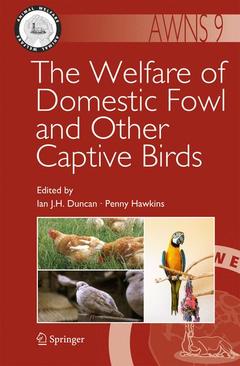Description
The Welfare of Domestic Fowl and Other Captive Birds, 2010
Animal Welfare Series, Vol. 9
Coordinators: Duncan Ian J. H., Hawkins Penny
Language: English
Subjects for The Welfare of Domestic Fowl and Other Captive Birds:
The Welfare of Domestic Fowl and Other Captive Birds
Publication date: 05-2012
298 p. · 15.5x23.5 cm · Paperback
Publication date: 05-2012
298 p. · 15.5x23.5 cm · Paperback
The welfare of domestic fowl & other captive birds (Animal welfare, Vol. 9)
Publication date: 03-2010
298 p. · 15.5x23.5 cm · Hardback
Publication date: 03-2010
298 p. · 15.5x23.5 cm · Hardback
Description
/li>Contents
/li>Comment
/li>
Animal welfare is attracting increasing interest worldwide, especially in developed countries where the knowledge and resources are available to (at least potentially) provide better management systems for farm animals, as well as companion, zoo and laboratory animals. The key requirements for adequate food, water, a suitable environment, appropriate companionship and good health are important for animals kept for all of these purposes. There has been increased attention given to farm animal welfare in many co- tries in recent years. This derives largely from the fact that the relentless pursuit of nancial reward and ef ciency, to satisfy market demands, has led to the devel- ment of intensive animal production systems that challenge the conscience of many consumers in those countries. In developing countries, human survival is still a daily uncertainty, so that p- vision for animal welfare has to be balanced against human needs. Animal welfare is usually a priority only if it supports the output of the animal, be it food, work, clothing, sport or companionship. In principle the welfare needs of both humans and animals can be provided for, in both developing and developed countries, if resources are properly husbanded. In reality, however, the inequitable division of the world?s riches creates physical and psychological poverty for humans and a- mals alike in many parts of the world.
Captive Birds.- Human–Bird Interactions.- The Welfare Implications of Housing Captive Wild and Domesticated Birds.- Training Companion Birds.- The Welfare of Captive Birds in the Future.- Domestic Fowl.- The Physical Environment and Its Effect on Welfare.- Nutrition, Feeding and Drinking Behaviour, and Welfare.- The Impact of Disease on Welfare.- Managing Poultry: Human–Bird Interactions and Their Implications.- The Welfare and Ethical Assessment of Housing for Egg Production.- Stunning and Slaughter.- The Future of Poultry Welfare.
Describes appropriate living conditions for captive wild and domesticated birds Gives instructions on how to manage captive birds in order to maximise their welfare Describes the effects of human-bird interactions on the birds’ behaviour and welfare
© 2024 LAVOISIER S.A.S.




